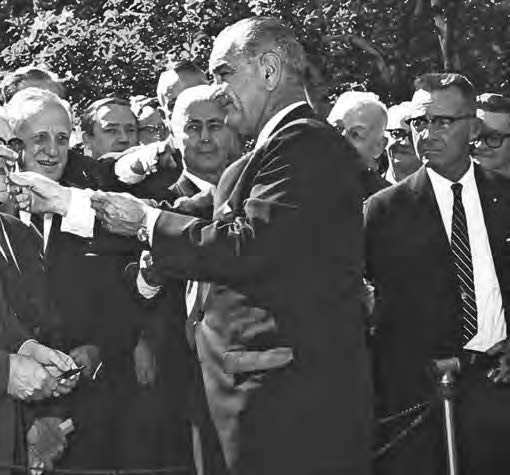A band of Izaak Walton League members was instrumental in blazing the trail that led to passage of the Wilderness Act in September, 1964. That path wound through many states, including Minnesota and the Superior National Forest, to a place that would be designated as the Boundary Waters Canoe Area Wilderness, now the nation’s most visited wilderness area.
Indelible efforts by Sigurd Olson and Will Dilg—who were both early leaders in the young Izaak Walton League—led directly to the 1926 protections for that region. The Boundary Waters would become emblematic of the wilderness cause that gained momentum over four decades, and the area was included in the initial nine million acres protected by the 1964 law.
The Act established a congressional process to add acres to the new National Wilderness Preservation System.
A native of Wisconsin, Olson first explored northern Minnesota as a young man in 1921. By 1923, he had relocated to Ely, Minnesota where he worked as a guide for trips to the nearby forest and waterways. Izaak Walton League founder Will Dilg and other members traveled to Minnesota where Olson briefed them on the unsustainable logging operations in the Superior National Forest.
Dilg and the League vowed to help. The immediate threat to the Boundary Waters was a U.S. Forest Service plan to build roads into the Superior, which would have hastened the loss of forest and degradation of the waterways. Conservation prevailed. The road was cancelled, and Agriculture
Secretary William Jardine declared protection in 1926 for “not less than 1,000 square miles of the best canoe country in the Superior without roads of
any character.”
These early efforts to prevent roads into wilderness area foreshadowed many battles that would follow to preserve roadless areas that protect wilderness, healthy streams and wildlife habitat—and provide incredible opportunities for fishing, hunting, hiking and other outdoor recreation.
But there were more early battles over the Boundary Waters. A proposed hydroelectric dam was opposed and stopped, thanks to advocacy by the League and an act of Congress in 1930. Continuing development and logging pressure in the region prompted President Franklin Roosevelt to appoint a commission to monitor the U.S.-Canada border region in 1934.
That Quetico-Superior Committee included conservation advocates Ernest Oberholtzer and Bob Marshall, who with several others, decided to
create a national organization devoted to protecting wilderness, which they would call the Wilderness Society, founded in January 1935.
The 1940s brought another challenge—dozens of daily float-plane flights into the Boundary Waters that dramatically altered the wilderness character of the region. Again, Olson and colleagues argued their case to Congress, and the 1948 Thye-Blatnik Act provided funds to buy the private resorts within the Boundary Waters, thereby eliminating the demand for the float-plane flights. That act of Congress borrowed a long-standing strategy employed by the Izaak Walton League Endowment to purchase private inholdings for resale to the Forest Service. The purchases of the private cabins and lands reduced the conflicts over use and promoted better management as wilderness.
During the mid-1950s, Olson joined the national staff of the Izaak Walton League where he served as its wilderness ecologist. His colleague Joe Penfold, the League’s conservation director, was also deeply immersed in the push for getting the wilderness bill through Congress.
 League Conservation Director Joe Penfold (right) played a significant role in passing laws that created the National Wilderness Preservation System and the Land and Water Conservation Act. He attended the ceremony in September 1964 where President Johnson (center) signed both bills into law.
League Conservation Director Joe Penfold (right) played a significant role in passing laws that created the National Wilderness Preservation System and the Land and Water Conservation Act. He attended the ceremony in September 1964 where President Johnson (center) signed both bills into law.
Penfold was the prime mover behind the influential Outdoor Recreation Resources Review Committee, created in 1958, that developed a
constituency, policy foundation and momentum for the Wilderness Act, the Land and Water Conservation Fund and other bedrock laws and
policies that would be adopted in the 1960s.
Mike Penfold, Joe’s son, served for 35 years in the Forest Service and then the U.S. Bureau of Land Management beginning in 1960. Mike recalled
how a final hurdle was cleared for passage of the wilderness bill. There was a sticking point between Representatives John Saylor and Wayne Aspinall
over legislative language.
“Pop sat down with Aspinall, knowing the problem that Saylor had with the bill, and he drafted alternative language that he knew Saylor would accept,” Penfold recalled. “With that problem solved, the path to passing the Wilderness Act into law would be easy.” Read more about Joe Penfold’s legacy in Outdoor America Issue 2, 2022.
When enacted in 1964, the National Wilderness Preservation System included 9.1 million acres spread across 54 wilderness areas in 13 states. Today,
the Act protects more than 111 million acres across 806 wilderness areas in 44 states.
Top photo: In the 1920s, the League began work to safeguard what is now called the Boundary Waters Canoe Area Wilderness in Minesota, which was protected in the 1964 Wilderness Act. Credit: Sam Wagner Timelapse.